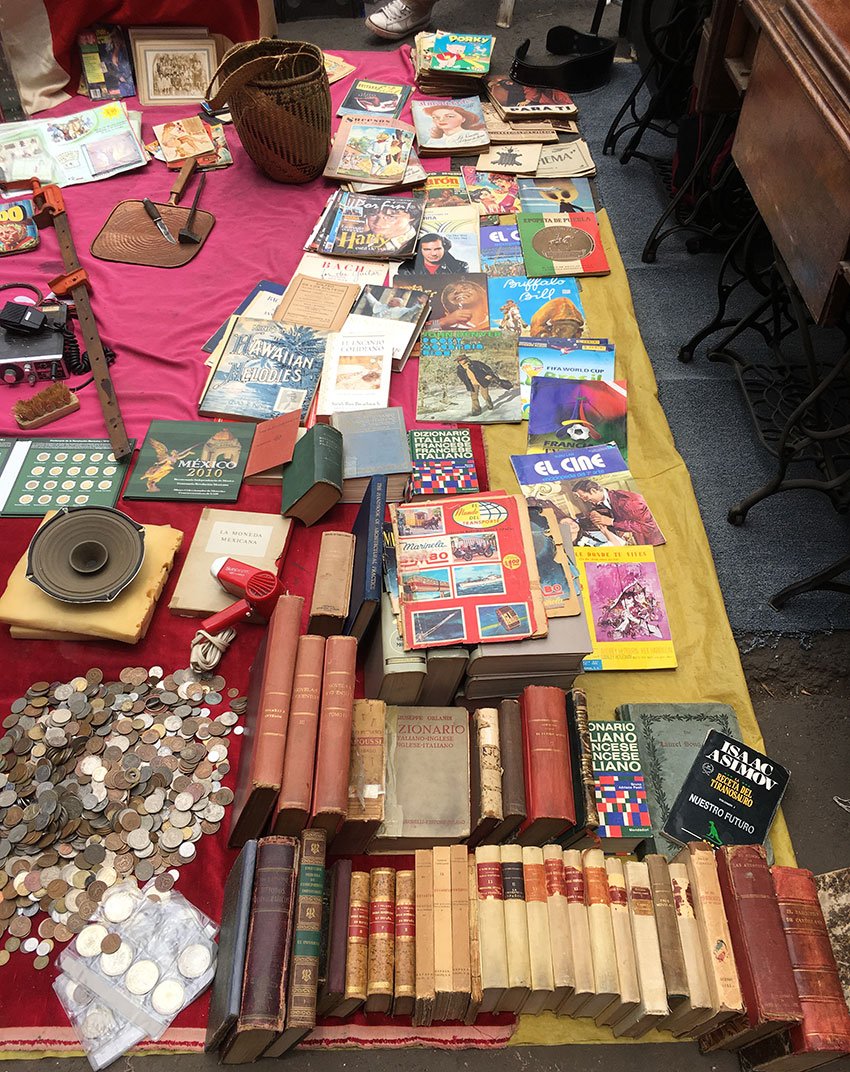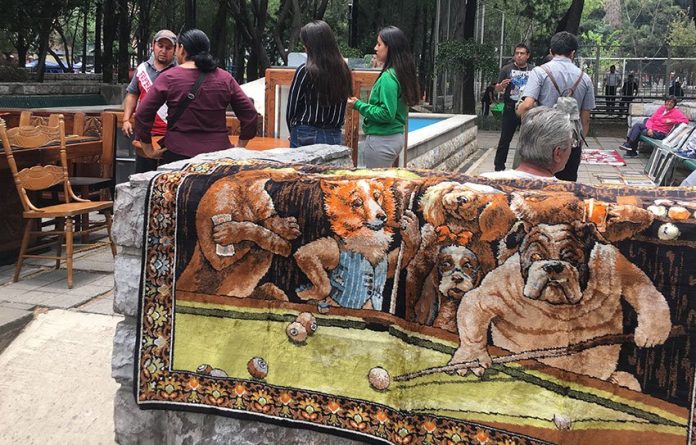Every Saturday and Sunday at Jardín Dr. Ignacio Chavez in Mexico City’s Colonia Doctores, the Tianguis de Antigüedades is a laid-back scene.
Crowds meander through the park, thoughtfully surveying the goods as romantic ballads and salsas play from some of the many vintage radios and turntables up for sale.
The merchandise ranges from cheap trinkets to genuine collectible treasures on this stretch of Avenida Cuauhetémoc, a space that only became a park after the Cine Internacional and government building were destroyed in the 1985 earthquake.
Vendors hang out together or with similarly-minded collectors, sharing photos of recent finds on their phones, smoking cigs, and sipping the occasional beer semi-hidden under a table or chair.
There is military paraphernalia from around the world (somewhat disturbing that it’s mostly from the Nazis), coins and pins, train sets and toy collectables, beautiful jewelry and china, vintage magazines and depraved comedic cartoon art.
As I sit taking notes, a vendor chats me up. “Are you writing in English or Spanish?” she asks.
She looks like a protective auntie in her cap with a neck flap and a sensible cotton button-down. She sells these flap hats, along with a hodgepodge of books, candle lanterns, tea sets and toy farming equipment.
“Sales are slow these days,” she says. “When there are people it’s good, but when there’s no one, it’s bad. Everyone’s on vacation right now. It’s usually really full.”
Lidia Huerta, it seems, was searching for someone to chat with. “Foreigners, when they like something, they just buy it. The peso is low for them. For Mexicans, it’s more about the price. People don’t have money to pay for things. Kids want to have fun and parents have to pay for all of it.”
“People with two legs and two arms should work,” she continues. “Mexicans like to work. But some people don’t want to.”
“You know what colonia we’re in?” she asks.

“Doctores?” I say.
“Yeah. This is Doctores. Right over there is Roma,” she says, pointing west across the park.
“This way,” she says, pointing the opposite direction. “It’s not very good over there. A lot of criminals. Be careful in Mexico.”
I dutifully tell her that I’ll watch out for myself and move on through the market.
Three generations sit together behind a row of tables offering vintage shoes and jewelry, expertly cracking pumpkin seeds while they make deals. It’s the kind of place where vendors enjoy the haggle. As far as I can tell, it’s usually padded into the price. You won’t always get the price you want, but sellers enjoy dickering so much that they might just do it for you.
I ask a vendor about his stuffed anteater. It looks like it’s been in a scuffle or two since it was first taxidermied but is in pretty good shape.
“One thousand five hundred,” he tells me. “Because some of the claws are missing. They took some off to make necklaces.” He shows me the animal’s left side, the paws completely bare of claws.
“I’ll think about it,” I say.
“They go for like 2,000 to 3,000 pesos in other places. This one’s African. It’s the smallest of the anteater species. One thousand five hundred is a good deal, on account of the claws.”
“I like it, but I don’t think my girlfriend would like it.”
“Mount your mother-in-law on the wall!” a nearby saleswoman yells to the laughter of the crowd.
“I don’t know. I’ll think about it,” I tell the anteater man.

“You tell me how much,” he says. Then, lowering his voice to a whisper, “Eight hundred. It’s cheap.”
I back out of the situation as another piece catches my eye. And this one is the stereotypical women-hate-it item, the classic “I’m Sam Malone from Cheers watch me toss peanuts into my mouth and talk about bras” kind of artwork: a scene of dogs shooting pool! On a rug!
It’s like a kitsch backflip!
“It’s 1,200,” the man with the rug tells me. “And that’s down from 1,500 because it’s getting to the end of the day. Made in Italy. It’s a collectible. It’s not like I have five or six more of these at home. Look at this stitching. Perfectly made. No stains. Never cleaned. You don’t clean good rugs like this, just beat the dust off them. It’s a great price. Real classic scene, this one. Made in Italy!”
All of this info appears to be true, but I waver. “I’ll think about it,” I say, as I walk away, certain to have baited the trap.
But this guy doesn’t chase me, doesn’t even try to tempt me back with a measly 50-peso reduction. Perhaps he’s better at this than I am.
With a well-tended pushbroom mustache over a handsomely wrinkled face, graying ponytail and bent silver glasses, Francisco Ordulla could certainly be picked out of any police lineup as a vintage LP vendor, and that’s exactly what his position has been here, pretty much since the market’s outset, for 20-something years.
It’s mostly American and British rock from the 60s and 70s on display, but Ordulla doesn’t really specialize in anything. He has classical, jazz, blues and native music from around the world, but most of his returning clients are in search of Mexican rock and psychedelia from the 70s.
“There weren’t as many printed as the American and British stuff, so it’s harder to find,” he says. “Me, I’m always looking for the Italian progressive rock from the 70s.”
He reckons it’s been the last five years or so that LPs have become really collectible in Mexico, so they’re only getting harder to find.
On the north side of the park are some of the larger pieces, big beautiful dressers and mirrors, some of the pricier statues and larger artworks. Lines of old Volkswagen buses, their seats removed for more efficient hauling, watch over their masters on the street behind.
A man with a magnifier stuck in his eye invites me to sit and ask some questions. His name is Javier Gómez and he fixes and sells antique clocks and watches. He’s been at the tianguis nearly every weekend for 25 years. During the week he makes house calls or works out of his house.
While we talk, a man casually hands him a can of New Mix tequila and grapefruit soda. “I owe you one,” Gómez tells him. He says that old stopwatches, watches that chime the hour and wall clocks with moving figures and music are among the hardest to fix. The most expensive pieces he sells are made by the Swiss, of course: Rolex and Patek Philippe.
Across the way, Diego Villegas appears to be one of the youngest and most popular vendors. He’s been selling used video games at the tianguis for five years and says his customers range from 10 to 50 years old.
He deals in most games and consoles, but Super Nintendo cartridges like “Megaman,” “Metroid,” “Donkey Kong,” and “Teenage Mutant Ninja Turtles” are the most popular these days, generally ranging from 100 to 1,200 pesos.
He says the Holy Grail for collectors at the moment is the Little Samson game for the Nintendo Entertainment System (NES) that can run from 50,000 pesos, without the case, to around 180,000 in mint condition. (There’s a slightly worn one for sale on eBay for 65,500 pesos at the moment.)
It’s often difficult to leave the Tianguis de Antigüedades without making at least one purchase. You can most definitely find something small and old for as little as 20 pesos, and I wet my whistle with a UNAM Pumas pin, a Puma skull and crossbones for 40 pesos.
Yet, I still can’t get the rug off my mind. I devise a plan to start low and get to my price (800) incrementally.
“Seven hundred,” I say to the rug guy, blowing it from the outset.
“No. Look here, man. One thousand two hundred was a good deal. Okay, okay, 1,000.”
I stare ahead sternly, rub my face, look to the sky like a man who knows the price of an authentic Italian rug featuring dogs playing billiards. “Okay. A thousand.”
I fork it over, accepting my place in the world of bargainers. He approaches the vendor next to him to borrow a bag for my rug. She hands him the bag, then eyes me standing there.
“Oh, it’s for this guy?” she says. “If I knew it was for the blondie I would’ve charged you for the bag.”
• Tianguis de Antigüedades Jardín Dr. Ignacio Chavez (alternately called Mercado or Bazar de Cuauhtémoc) runs Saturdays and Sundays, 9:00am to 4:00pm, along Avenida Cuauhetémoc between Dr. Liceaga and Dr. Juan Navarro in Colonia Doctores.
This is the eighth in a series on the bazaars, flea markets and markets of Mexico City:
- Mexico City’s most colorful market is Mercado Jamaica, the flower market
- You’ll find art at Mercado Coyoacán, but the main attraction is food
- MercadoRoma, a Mexican public market reimagined for the 21st century
- Tuesdays in Taxqueña, the flea market of musical brotherhood
- Escandón Market is quintessential middle-class CDMX neighborhood market
- A walk through the Mexico City markets of Colonia La Condesa
- The San Juan market, Mexico City’s epicenter for culinary inquisition
